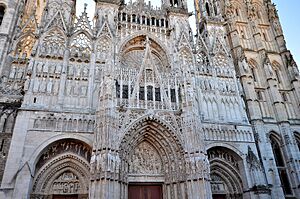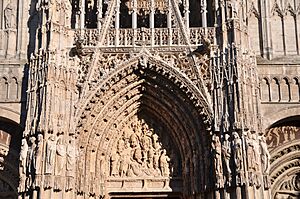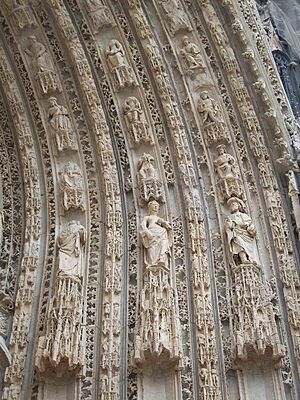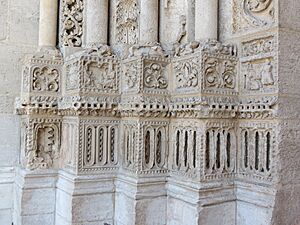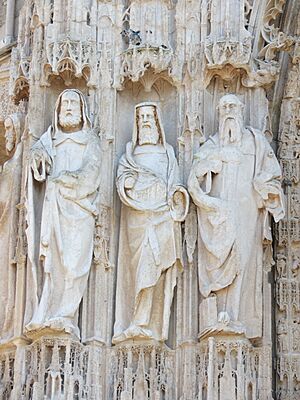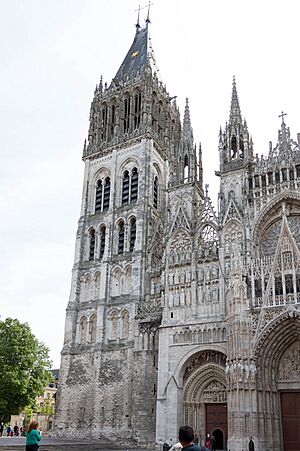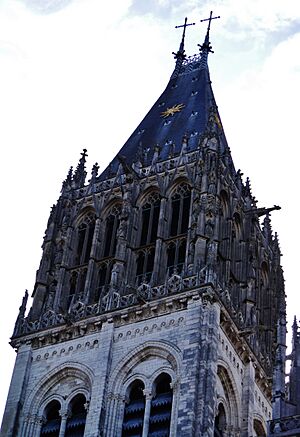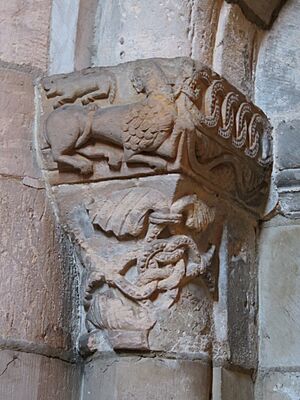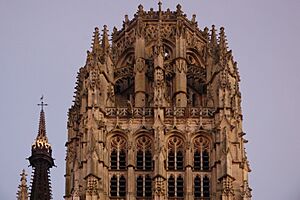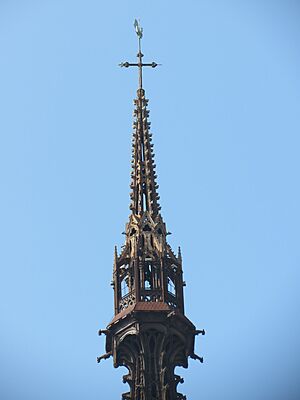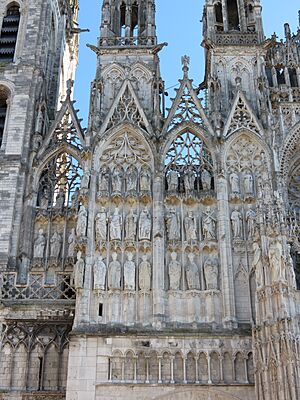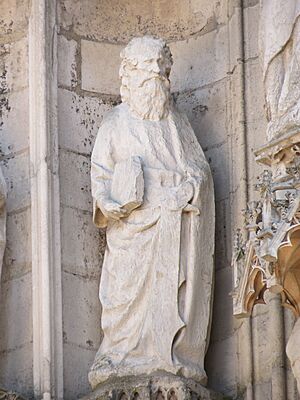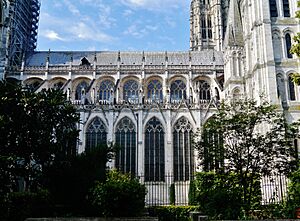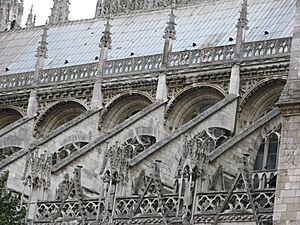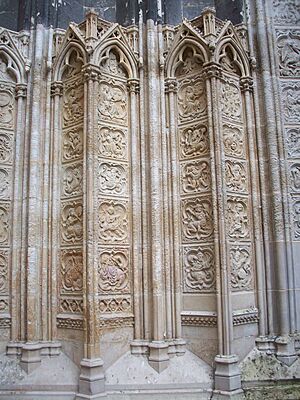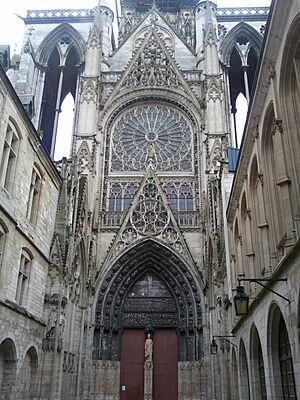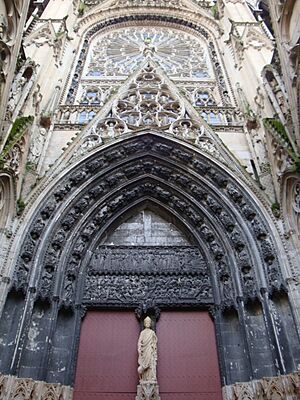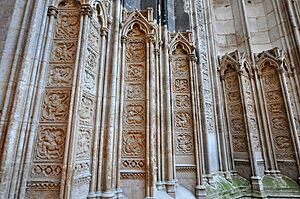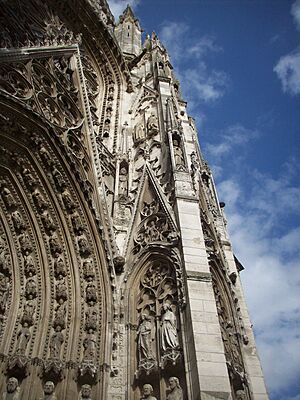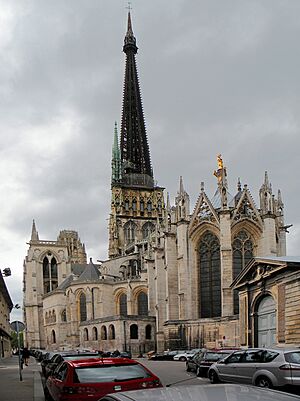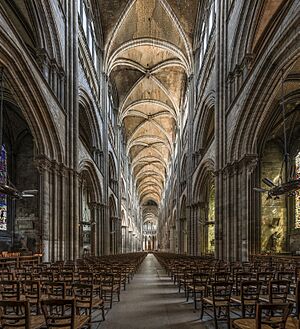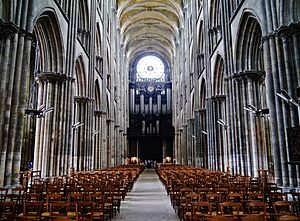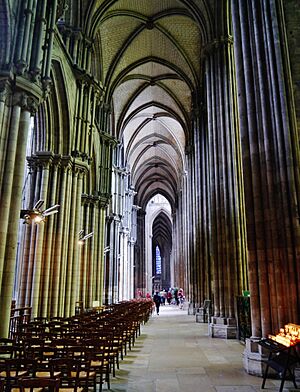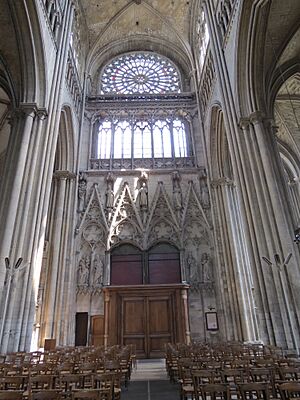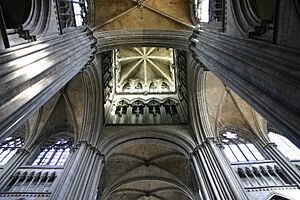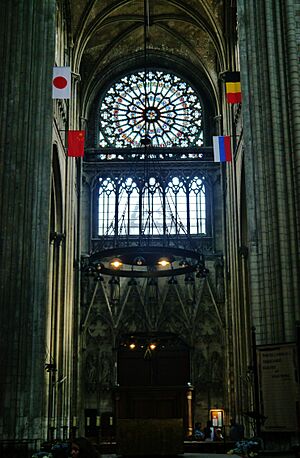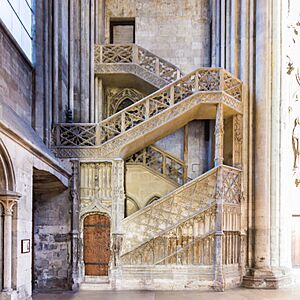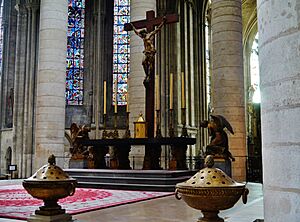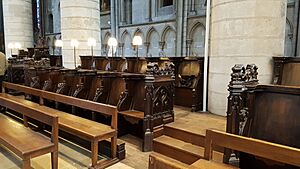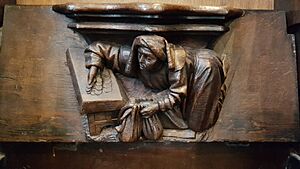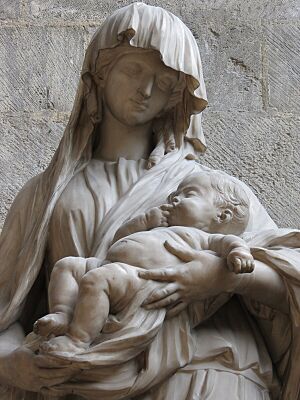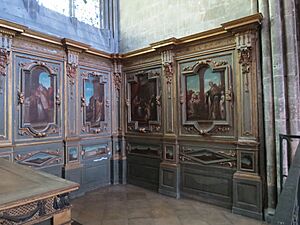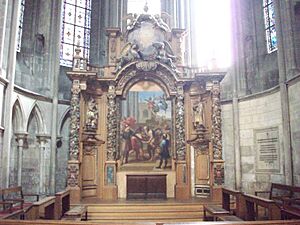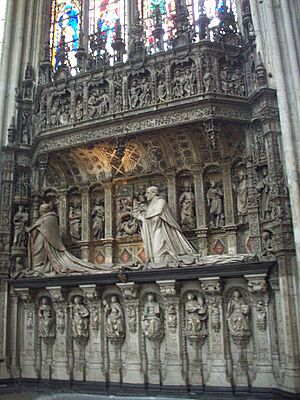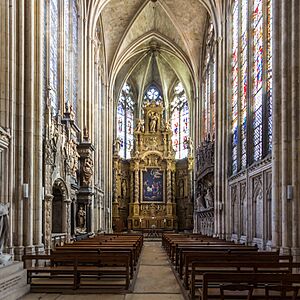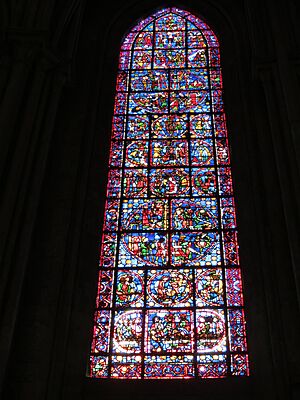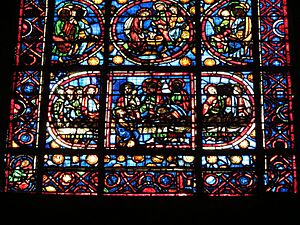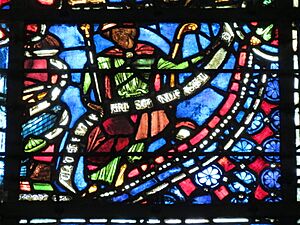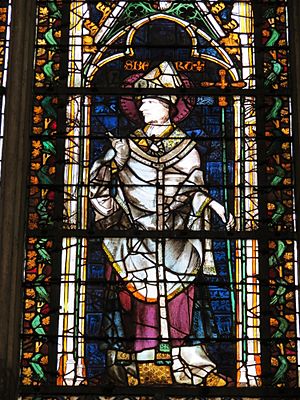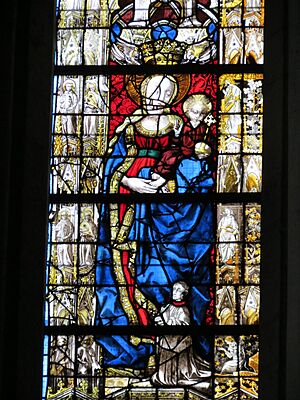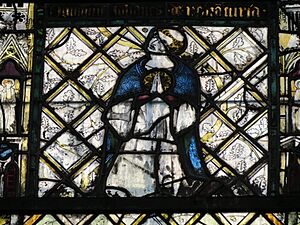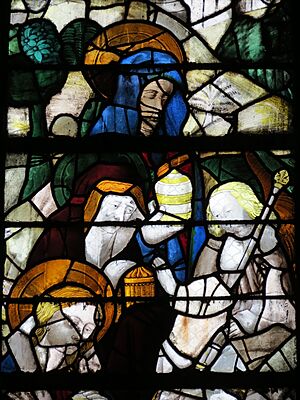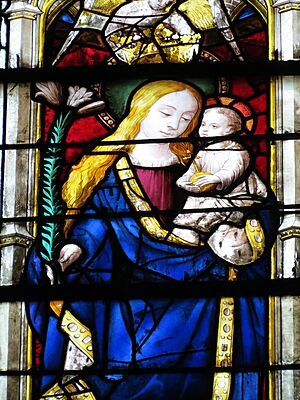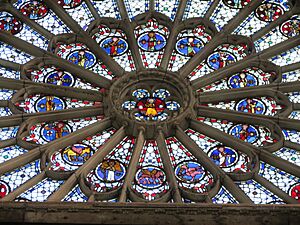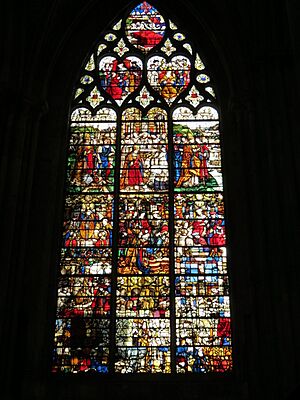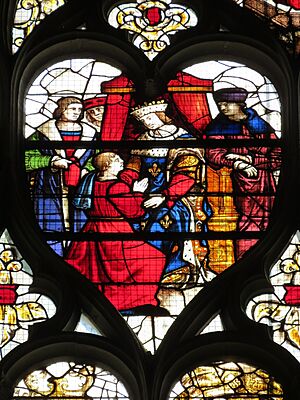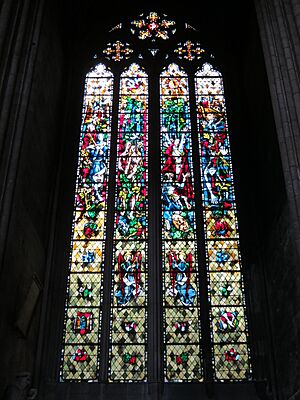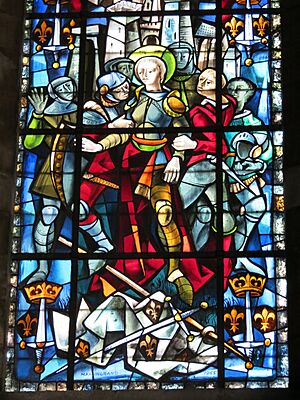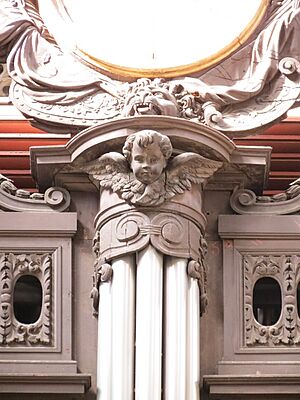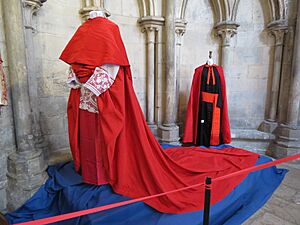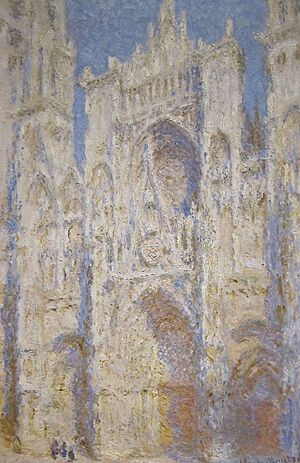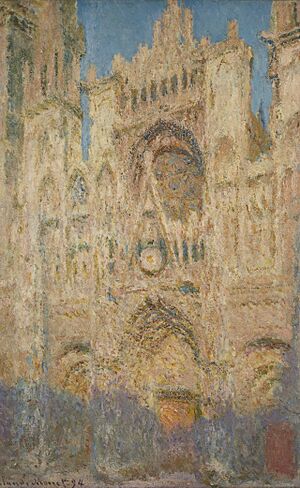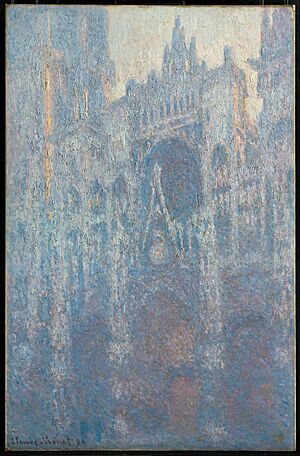Rouen Cathedral facts for kids
Quick facts for kids Rouen Cathedral |
|
|---|---|
| Primatial Cathedral of Notre-Dame de Rouen | |
|
Cathédrale primatiale Notre-Dame de l'Assomption de Rouen (French)
|
|
 |
|
| Location | 3 rue Saint-Romain 76000 Rouen, Normandy France |
| Denomination | Catholic Church |
| Website | |
| History | |
| Status | Cathedral |
| Dedication | Assumption of Mary |
| Consecrated | 1 October 1063 in the presence of William the Conqueror |
| Relics held | Saint Romain |
| Architecture | |
| Functional status | Yes |
| Heritage designation | Classée Monument Historique |
| Designated | 1862 |
| Architectural type | church |
| Style | Gothic |
| Groundbreaking | 1030 |
| Completed | 1880 |
| Specifications | |
| Number of towers | 2 |
| Number of spires | 2 |
| Administration | |
| Archdiocese | Rouen |
The Rouen Cathedral is a famous Catholic church in Rouen, Normandy, France. It is the main church for the Archbishop of Rouen. The cathedral is well-known for its three towers, each built in a different style.
This amazing building was constructed and rebuilt over more than 800 years. It shows many different styles, from early Gothic to later Flamboyant and Renaissance architecture. The cathedral is also famous in art history because Claude Monet painted a series of Impressionist paintings of it. From 1876 to 1880, it was even the tallest building in the world!
Contents
History of Rouen Cathedral
Early Churches on the Site
Christianity came to Rouen around 260 AD. The first church was likely built where the cathedral stands today. In 395, a large church with three main sections was built on the same spot.
Later, in 755, Archbishop Rémy started the first group of clergy for the cathedral. He also built courtyards and buildings around the church. However, from 841, Vikings attacked the area many times, damaging the church.
The Viking leader Rollo became the first Duke of Normandy. He was baptized in the church in 915 and buried there in 933. His grandson, Richard I of Normandy, made the church even bigger around 950.
In the 1020s, Archbishop Robert began to rebuild the church in the Romanesque style. This new Romanesque cathedral was officially opened on October 1, 1063. William the Conqueror, who would soon conquer England, was there for the event.
Building the Gothic Cathedral
The idea for a new cathedral in the Gothic style started in 1145. Archbishop Hugues of Amiens began building a tower, now called the Saint-Roman Tower. He wanted the church to have lots of light inside, a key feature of Gothic buildings.
A full rebuilding of the cathedral began in 1185. Work was stopped by a big fire in 1200, which damaged the unfinished church. But the damage was quickly fixed, and construction continued. By 1204, the main part of the church was ready for King Philip II of France to visit.
Over time, more parts were added. Small chapels were built along the sides of the main hall. In 1280, new entrances were added to the north and south sides. A much larger chapel, dedicated to the Virgin Mary, was started in 1302. The front of the church also got new decorations between 1370 and 1450.
In 1468, a very fancy new top was added to the Saint-Romaine tower. It was made of iron and stone tiles in the late Gothic Flamboyant style.
Changes in the 1500s
Cardinal-Archbishop Georges d'Amboise (1494-1510) had a big impact on the cathedral. He added new Renaissance features to the Gothic design. A new tower, called the Butter Tower, was started in 1488. It was named this because people donated money for it by getting permission to eat butter and milk during Lent.
While the new tower was being built, the front of the cathedral started to lean. Cardinal d'Amboise ordered it to be completely rebuilt. This was done in a very ornate Flamboyant style, with lots of stone lace-like patterns and hundreds of sculptures. Two huge buttresses (supports) were added to make the front stable.
In 1514, the wooden spire (tall, pointed top) of the central tower fell. It was quickly replaced with a new one that looked exactly the same.
From the 1600s to the 1800s
In the late 1500s, the cathedral was badly damaged during the French Wars of Religion. In 1562, Protestants attacked the church, destroying furniture, tombs, and stained-glass windows. The cathedral was also hit by lightning in 1625 and 1642, and by a hurricane in 1683.
During the French Revolution in 1796, the government took over the cathedral. For a time, it was used as a "Temple of Reason." Some of its art and furniture were sold.
In 1822, lightning caused a fire that destroyed the wooden spire of the central tower. An architect named Jean-Antoine Alavoine suggested replacing it with a new spire made of cast iron. This idea was very controversial. The new iron spire, 151 meters (495 feet) tall, was finished in 1882. For a short time, from 1876 to 1880, this spire made Rouen Cathedral the tallest building in the world!
The 1900s and Today
In 1905, the cathedral became the property of the French government. However, the Catholic Church was still allowed to use it.
During World War II, the cathedral was hit twice by Allied bombs in 1944. Seven bombs hit the building in April, damaging the south side. In June, bombs set fire to the Saint-Romain tower, melting the bells.
After the war, a huge effort began to repair the damage. This work finished in 1956. More restoration projects continued for decades, including fixing the sculptures on the west front. In 2016, the scaffolding that had covered much of the cathedral for 50 years was finally removed.
In 1999, a strong storm caused a copper-covered wooden turret (small tower) to break off and fall into the church, damaging the choir area.
On July 11, 2024, the central spire of the cathedral caught fire during renovation work. Firefighters quickly brought the fire under control.
Timeline
- c. 260 - Saint Mellonius becomes the first bishop of Rouen.
- c. 396 - Bishop and Saint Victricius builds the first large church.
- 769 - Charlemagne visits the Cathedral for Easter.
- 1063 - The Romanesque cathedral is officially opened.
- 1145 - Reconstruction in the Gothic style of the Saint Roman tower begins.
- 1200 - A fire causes major damage to the cathedral's inside.
- 1207 - The main altar is put in place.
- c. 1247 - The Gothic cathedral is mostly complete.
- 1280 - New entrances to the transept begin construction.
- 1302 - Work starts on the Chapel of the Virgin.
- 1370 - The Rose window on the west front begins construction.
- 1478 - The upper part of the Tour Saint-Romain is finished.
- 1485-1506 - Construction of the Butter Tower.
- 1508 - Restoration of the west front begins with new decorations.
- 1514 - The Gothic spire on the bell tower burns and is quickly rebuilt.
- 1562 - The Cathedral is damaged by Protestants during religious wars.
- 1683 - A hurricane causes major damage.
- 1796 - The French Revolution briefly turns the Cathedral into a "Temple of Reason."
- 1822 - A fire destroys the Renaissance spire.
- 1884 - The spire is replaced by a new one made of cast iron and copper.
- April and June 1944 - The Cathedral is damaged by Allied bombing during World War II.
- 1980s - Restoration of World War II damage is completed.
- December 26, 1999 - High winds cause a copper and wood turret to fall through the roof.
- 11 July 2024 - The spire is damaged by fire.
Outside the Cathedral
The West Front
The west front is the main entrance to the Cathedral, with three large doorways called portals. It was built and redone many times, each time becoming more decorated.
The main portal is dedicated to the Virgin Mary. Above the doorway, in the arch called the tympanum, you can see a "Tree of Jesse." This shows the family tree of Jesus. The arches above are filled with sculptures of prophets and other figures.
The portals on either side also have sculptures telling Bible stories. The left portal shows scenes from the life of John the Evangelist. The right portal is dedicated to Saint Stephen and shows his story. Traces of color show that all these sculptures were once brightly painted.
Large supports called buttresses were added on either side of the main portal in the 1300s to make the front stronger. They are also covered with sculptures.
Saint-Romain Tower
The Saint-Romain Tower is on the left side of the west front. It was started in 1145. The very decorative top was added in the 1400s. This tower holds the largest bell, named Joan of Arc, which weighs 9.5 tons. It also has 64 smaller bells that make up a carillon, which was fixed in 2016. It's the second-largest carillon in France.
Butter Tower
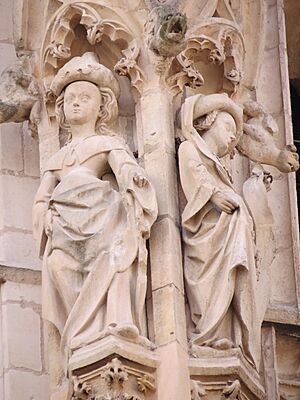
The Butter Tower was built between 1488 and 1506. It's called the Butter Tower because people gave money to build it in exchange for special permission to eat butter and milk during Lent. The tower has lots of detailed decorations, like tall pointed niches for sculptures and fancy buttresses. At the very top, the tower changes from a square to an octagon with a beautiful stone crown.
Central Lantern Tower and Spire
A central tower with a spire is common in Gothic churches in Normandy. This tower is above the middle part of the church and is 151 meters (495 feet) high, making it the tallest of the three towers. The first spire was destroyed by fire in 1514 and rebuilt in wood and lead.
Another fire in 1822 destroyed that spire. It was then replaced by a new one made of iron and copper, finished in 1882. This new spire is surrounded by four smaller copper spires. One of these fell during a hurricane in 1999, damaging the inside of the church. On July 11, 2024, the main spire caught fire again.
Smaller Towers and Sculpture Galleries
In the 1200s, four smaller towers, called tourelles, were added on top of the buttresses that support the west front. Later, in the 1300s, three gables (pointed decorative elements) were added below each tourelle. These gables are filled with sculptures of archbishops, apostles, saints, kings, and prophets, adding to the detailed look of the west front.
Along the sides of the cathedral, you can see flying buttresses. These are strong supports that reach over the lower roofs to hold up the tall upper walls of the main hall (the nave). Because of these supports, the upper walls of the nave can have very large windows. The edges of the roofs are also beautifully decorated with balustrades and pinnacles.
North Transept Entrance
There are two very decorated entrances, one on the north and one on the south, that lead into the transept (the part of the church that crosses the main hall). The north entrance is called the Portail des Librairies. It has a statue between its doors and a tympanum full of sculptures. Above this, there are three bands of statues and a lace-like pointed gable that rises up in front of the windows. The doorway also has delicate sculpted medallions.
South Transept Entrance
The front of the south transept and its entrance, the Portal of La Calende, are even more covered with sculptures. The scenes above the doorway show the life of Christ. The supports on either side have niches filled with angels and prophets. Around the doorway, there are medallions illustrating the Book of Genesis and fantastic animals. Scenes of the Last Judgment are above the tympanum. At the very top, above the rose window, is another gable with a sculpture of the Virgin Mary being crowned.
The East End (Chevet)
The most important part of the east end of the Cathedral is the chapel dedicated to the Virgin Mary. It extends far out from the main church. It has very tall buttresses topped with statues and high windows with gables. Above everything is the "Golden Virgin," a gilded statue of the Virgin Mary made in 1541.
Smaller chapels are located between the buttresses on the north and south sides of the Virgin Mary Chapel.
Inside the Cathedral
Layout of the Cathedral
The nave is the main part of the cathedral where people sit. It goes from the west front to the transept and choir. The ceiling is made of four-part rib vaults, supported by columns that reach down to the large pillars on the ground floor.
After the fire in 1200, the design of the nave was changed. It now has three levels: an arcade of pillars on the ground floor, a narrow passageway above that, and then the high windows (clerestory) that let in light. These changes were possible because of flying buttresses, which support the upper walls from the outside, allowing for thinner walls and larger windows.
The side aisles are 14 meters high, while the main nave vault is 28 meters high. The high windows of the central nave look over the roofs of the side aisles, bringing more light into the church.
Transept
The transept is very large and bright because of the big rose windows on the north and south sides. You can see the inside of the lantern tower above. The walls inside are richly decorated with stone patterns and sculptures. In the northwest corner, there is a stairway from 1471 that led to the cathedral's library.
Choir
The Choir is the part of the cathedral at the east end, reserved for the clergy (church leaders). It was built after the nave, in the mid-1200s, so its style is more consistent. The main altar and the Archbishop's throne mark the beginning of the Choir. Beyond that are the stalls where the clergy sat.
The Choir has three levels: circular pillars, a gallery above, and then high windows that form a half-circle.
The center of the Choir was greatly updated in 1956 after being damaged in the war. A new high altar was added, topped by an 18th-century statue of Christ. The Choir also received new screens, a new throne for the bishop, and a modern communion table and pulpit.
Choir Stalls
The choir stalls were put in place between 1457 and 1470. Most of the original seats are still there, with carved decorations called misericords. These carvings show scenes from the Bible, proverbs, fables, and craftsmen at work. Sadly, the upper parts of the stalls were destroyed during the French Revolution.
Tombs of the Dukes of Normandy

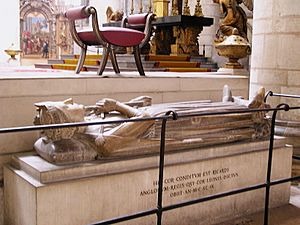
The remains of four Dukes of Normandy are in simple tombs on either side of the choir. These include Rollo, the first Duke of Normandy, and William Longsword, his son. Also here are Henry the Young King and a tomb holding the heart of Richard the Lionheart, who was a Duke of Normandy and King of England.
Rollo's original tomb was destroyed in the 1944 bombing and replaced with a copy. The remains of Rollo and William Longsword were moved to the Gothic cathedral when it was finished.
Side Chapels
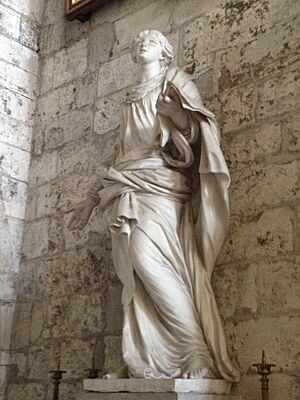
There are 18 small chapels between the buttresses on the north and south sides of the nave. They are filled with art, sculptures, and stained glass, often given by rich donors or city guilds. Some chapels are simple, while others have paintings and sculptures from the 1600s and 1700s. The Chapel of Sainte-Catherine is known for its detailed painted wood panels showing the life of Saint Brice. Most of the other chapels on the south side were destroyed in the 1944 bombing.
Chapel of the Virgin
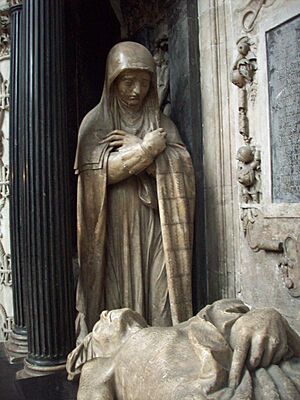
At the east end of the cathedral is the Chapel of the Virgin, dedicated to the Virgin Mary. It was started in 1302. The windows fill the upper part of the walls, and the lower walls are covered with detailed stone patterns and sculptures. Traces of gold and color show that the chapel was once very colorful.
The main feature is a huge altar from the 1600s. The chapel also holds the tomb of Cardinal Georges d'Amboise, who was a major supporter of the Gothic cathedral, and his nephew.
Another important tomb in the chapel is that of Louis and Pierre de Brézé, made between 1536 and 1541 in a pure Renaissance style. Louis's wife, Diane de Poitiers, who was King Henri II of France's mistress, ordered this tomb. It shows Louis on horseback and as a corpse, with Diane kneeling beside him. This tomb is thought to be by the famous French Renaissance sculptor Jean Goujon.
Stained Glass Windows
A lot of the original stained glass from the 1200s is still in the cathedral. It is similar to the early windows in Chartres Cathedral. There are five sections with early glass in the side chapels of the north nave. These early windows are made of small, thick pieces of glass, mostly red and blue, joined together like mosaics with thin lead strips.
1200s Windows
The side chapels on the north side of the nave have some of the oldest windows. Some of these windows were paid for by groups of craftsmen and show them at work. Some windows, like the Window of Saint Joseph, are even signed by the artist.
The "Belles Verrieres"
The "Belles Verrieres" (Beautiful Glass) are a group of early 1200s stained glass windows. They were moved in the 1400s from their original spots and put into new windows in several chapels. The window in Bay 53 of the Chapel of Saint-Joseph-de-la-nef shows craftsmen planning and building Rouen Cathedral.
1300s–1400s Windows
Windows from the 1300s and 1400s look different from earlier ones. Artists started using new techniques to add more detail and make images look more realistic. The windows began to look more like paintings. They often showed saints and bishops in architectural settings, surrounded by fancy canopies. They also used more grisaille (greyish or white glass) to let in more light. The Pentecost window in Bay 36 is a good example.
Rose Windows (1400s)
The rose window of the north portal is the only large rose window that is still in its original form. It was made in the late 1300s and shows Christ surrounded by important figures like evangelists, bishops, kings, and martyrs.
Renaissance Windows (1500s)
The windows from the 1500s show the influence of the Renaissance. They are more realistic and look even more like paintings. The window in the Chapel of Saint-Joseph is a good example. While it has lots of detail, it doesn't have the same deep, rich colors as the older 1200s windows.
Other important 1500s windows are in the Saint-Romain chapel. They show scenes from the life of Archbishop Romaine, who is famous for getting rid of a monster called "The Gargoyle" in Rouen legends.
Modern Windows (1900s)
The Cathedral has many modern windows made in the 1950s. These replaced windows destroyed during World War II. They look similar in color and detail to the older medieval and Renaissance windows. An example is in the Chapel of St. Leonard. The three Joan of Arc windows in the Chapel of Joan-of-Arc are also striking examples, made in 1955–56.
Bells
The cathedral has 70 bells made by the Fonderie Paccard company. Sixty-four bells are in the Saint-Romain Tower, and six are in the Butter Tower. Together, they are the heaviest group of bells in France, weighing a total of 36 tons.
Grand Organ
The cathedral has had an organ since the 1380s. A larger new organ was built starting in 1488. It is located at the beginning of the nave, inside the west front, below the rose window. This organ was damaged in a hurricane in 1683 but was repaired. Famous organists like Jean Titelouze and Jacques Boyvin played here.
Treasury
The cathedral's treasury was originally in the Sacristy. It was later moved to its own tower on the Alban Courtyard. The treasury was robbed twice, first in 1562 and again in 1791. Most of the original items were lost. However, in the 1800s, a new collection was gathered from other churches and private collections.
Notable items include the Châsse de Saint Roman, a miniature cathedral made of gilded copper from the late 1200s. There's also the Châsse de Notre Dame, a mini-cathedral of gilded bronze from the 1800s. The treasury also displays some of the fancy ceremonial clothes worn by the Archbishops.
Crypt
The 11th-century crypt of the original Romanesque cathedral is located under the Gothic cathedral's choir. You can get to it through the Chapel of Saint Joan of Arc. It was dug out between 1931 and 1934 and opened to visitors in 1956. It has a sanctuary and a curving walkway with three small chapels. The original floor was made of light stone and black marble.
The Cathedral in Art and Literature
The most famous paintings of the cathedral were done by the Impressionist artist Claude Monet. He created a series of paintings showing the building at different times of day and in different weather. These paintings are now in museums around the world, and some are worth over $40 million.
Other artists like John Ruskin and Roy Lichtenstein were also inspired by the cathedral.
In literature, the writer Gustave Flaubert was inspired by the stained glass windows and sculptures. He based two of his Three Tales on them. Joris-Karl Huysmans wrote a novel called La Cathédrale, which is a deep look at the building.
Burials
The Cathedral holds a tomb with the heart of Richard the Lionheart. His body is buried in another location. Richard's image is on top of the tomb, and his name is written in Latin on the side.
The Cathedral also contains the tomb of Rollo, one of Richard's ancestors. Rollo was the founder and first ruler of Normandy.
A memorial plaque remembers John of Lancaster, Duke of Bedford. His original tomb was destroyed in the 1500s.
Other important people buried here include:
- Maurilius, an Archbishop of Rouen (died 1067)
- Poppa, wife of Rollo
- William I, Duke of Normandy
- Hugh of Amiens, an Archbishop of Rouen (died 1164)
- Matilda of England
- Walter de Coutances, an Archbishop of Rouen (died 1207)
- William FitzEmpress
- A memorial to Arthur I, Duke of Brittany, who was last seen in Rouen Castle in 1203.
- Henry the Young King, son of King Henry II of England
- Georges d'Amboise
- Pierre de Brézé
- Louis de Brézé, seigneur d'Anet
- Later Archbishops of Rouen like Gustave Maximilien Juste de Croÿ-Solre (died 1844), Pierre Petit de Julleville (died 1947), and Joseph-Marie Martin (died 1976).
Dimensions
| Dimensions | ||
|---|---|---|
| interior length | 136.86 m | |
| exterior length | 144 m | |
| height of northern crossing | 28 m | |
| height of southern crossing | 28 m | |
| central spire | total height of spire | 151 m |
| weight of spire | 8 000 t | |
| choir | choir length | 34.30 m |
| choir height | 28 m | |
| choir width | 12.68 m | |
| crossing tower | height of crossing tower | 51 m |
| façade | width of western façade | 61.60 m |
| nave | width of nave | 24.20 m |
| length of nave | 60 m | |
| height of vaults of main aisle | 28 m | |
| height of vaults of second aisle | 14 m | |
| width of central aisle | 11.30 m | |
| tower Beurre | height | 75 m |
| tower Saint-Romain | height | 82 m |
| transept | width of transept | 24.60 m |
| exterior length of transept | 57 m | |
| interior length of transept | 53.65 m |
See also
 In Spanish: Catedral de Ruan para niños
In Spanish: Catedral de Ruan para niños
- Gothic cathedrals and churches
- French Gothic architecture
- List of Gothic Cathedrals in Europe
- List of tallest structures built before the 20th century
- French Gothic stained glass windows
- Gothic architecture
- Church of St. Ouen, Rouen
- List of tallest churches
- André Bizette-Lindet
- Treaty of Louviers



